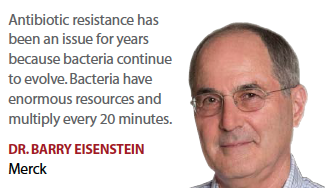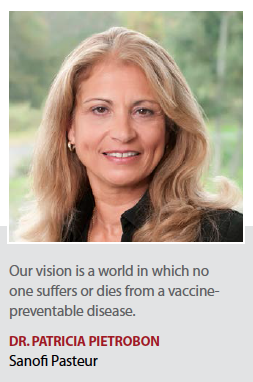 For the last 70 years, antibiotics have greatly reduced illness and death from infectious diseases. But these drugs have been used so widely and for so long that the infectious organisms the antibiotics are designed to kill have adapted to them, making the drugs less effective.
For the last 70 years, antibiotics have greatly reduced illness and death from infectious diseases. But these drugs have been used so widely and for so long that the infectious organisms the antibiotics are designed to kill have adapted to them, making the drugs less effective.
In the past 25 years, there has been a steady increase in the bacteria that have become immune to antibiotics. With the rise of resistance to the most widely used treatments and few new antibiotics in development, experts warn of a return to a pre-antibiotic era, where patients may die from seemingly minor infections.
In the United States alone, at least 2 million people acquire serious infections with resistant bacteria, and at least 23,000 people die each year as a direct result of these infections, according to the Centers for Disease Control and Prevention (CDC). In Europe, antibiotic-resistant bacteria kill 25,000 people every year, two-thirds from Gram-negative bacteria.
Antibiotic resistance is not new. Strains of Staphyloccus resistant to penicillin were identified as early as 1940 and more than 80% of strains were resistant by 1960. The occurrence of methicillin-resistant Staphylococcus (MRSA) first appeared in 1962, just two years after the drug’s launch and by 2002, more than 57% of Staphylococci in U.S. hospitals were resistant, according to the CDC.
 Antibiotic resistance has been an issue for years because bacteria continue to evolve, says Barry Eisenstein, M.D., distinguished physician, antimicrobials, Merck.
Antibiotic resistance has been an issue for years because bacteria continue to evolve, says Barry Eisenstein, M.D., distinguished physician, antimicrobials, Merck.
“Bacteria have enormous resources, namely because there are billions and billions of these bacteria multiplying as frequently as every 20 minutes," he says. “If they confront a threat to their existence, such as an antibiotic, many of them will die, but some will mutate or acquire new genes to avoid their death, which is something bacteria have been doing for billions of years through evolution."
Early on, most of the warnings about resistance were not particularly well-heeded, Dr. Eisenstein says.
“Resistance developed and continued, and there was a fair amount of general complacency in the medical community because the drug industry was able to keep up with resistance by discovering and developing new antimicrobials at a fairly regular rate," he says.
But, he says, about 20 to 30 years ago, after all of the easy-to-find natural products (the first generation of antibiotics) and the easy-to-generate chemical modifications of prior antibiotics were exploited, there were few new antimicrobials being discovered.
 “Because of how antimicrobials have been used and the propensity of bacteria to develop resistance, we have a problem now," says Kent Kester, M.D., R&D VP, translational medicine and biomarkers, at Sanofi Pasteur, and a member of the Presidential Advisory Council on Combating Antibiotic-resistant Bacteria. “There is never going to be a day when there’s no antimicrobial resistance. But I think we can make this situation better by rational use of antimicrobials and reserving the biggest guns if you will, the most broad-spectrum antibiotics, for the very worst infections and where they can make the greatest impact."
“Because of how antimicrobials have been used and the propensity of bacteria to develop resistance, we have a problem now," says Kent Kester, M.D., R&D VP, translational medicine and biomarkers, at Sanofi Pasteur, and a member of the Presidential Advisory Council on Combating Antibiotic-resistant Bacteria. “There is never going to be a day when there’s no antimicrobial resistance. But I think we can make this situation better by rational use of antimicrobials and reserving the biggest guns if you will, the most broad-spectrum antibiotics, for the very worst infections and where they can make the greatest impact."
The great fear is that more bacterial species will acquire resistance, and this is a public health concern because we may not be able to control even minor infections in the future, says Eszter Nagy, M.D., Ph.D., co-founder and chief scientific officer, Arsanis.
“When there are only one or two last-resort antibiotics with inferior safety profiles left to be used for a treatment, it’s a scary scenario," she says. “The Gram-negative pathogens are the most concerning infections in this respect because the antibiotic-resistant strains are abundant in our environment. This is a concern for the whole society."
To address the issue of resistance, public health officials and infectious disease experts have begun working with physicians on “antimicrobial stewardship," an approach for more careful use of antibiotics and using improved diagnostics to make sure the right antimicrobials are being used for the various infections.
In March 2015, the U.S. Health and Human Services released the National Action Plan for Combating Antibiotic Resistant Bacteria, which outlines steps for implementing a national strategy. This plan was developed in response to an executive order from President Barack Obama in September 2014.
 The hope is that by 2020, implementation of the National Action Plan will lead to major reductions in the incidence of urgent and serious threats, including carbapenem-resistant Enterobacteriaceae (CRE), methicillinresistant Staphylococcus aureus, and Clostridium difficile. More recently, on Sept. 15, 2015, the HHS, the U.S. Department of Agriculture, and the U.S. Department of Defense announced the appointment of nationally recognized experts to the Presidential Advisory Council on Combating Antibiotic-Resistant Bacteria.
The hope is that by 2020, implementation of the National Action Plan will lead to major reductions in the incidence of urgent and serious threats, including carbapenem-resistant Enterobacteriaceae (CRE), methicillinresistant Staphylococcus aureus, and Clostridium difficile. More recently, on Sept. 15, 2015, the HHS, the U.S. Department of Agriculture, and the U.S. Department of Defense announced the appointment of nationally recognized experts to the Presidential Advisory Council on Combating Antibiotic-Resistant Bacteria.
Globally, health officials are also considering how to address antibiotic resistance. In May 2015, the World Health Assembly endorsed a global action plan to tackle antimicrobial resistance. The World Health Organization is working with the United Nations to develop a framework for monitoring and evaluating resistance patterns, and they will develop action plans by the 2017 World Health Assembly.
The Industry’s Role
As the demand for new antimicrobials increases, the development of new antibiotics by the pharmaceutical industry has stalled due to economic and regulatory obstacles. In the decade from 1980 to 1989, 30 new antibiotics were approved. But in the decade from 2000 to 2009, only seven were approved, and from 2010 to 2014, just six new antibiotics were approved, according to data from FDA and the CDC.
Industry experts stress that the pharmaceutical industry plays an important role in developing more specific antibiotics, especially for the more challenging infections, such as Clostridium difficile, carbapenem-resistant Enterobacteriaceae, Klebsiella, pseudomona.
These and other Gram-negative infections are difficult to develop therapies against, because these infections have two membranes on the cell surface that antibiotics need to penetrate.
Additionally, the cells of these infections have six to 12 “pumps" imbedded on the surface that expel antibiotics that penetrate the surface.
“One of the biggest challenges in developing new antimicrobials is attrition," says David Payne, Ph.D., VP of antibacterial discovery at GlaxoSmithKline. “We lose a lot of molecules because of the high exposures needed to work against the bacterial infection, which then leads to toxicity issues."
Dr. Payne says another challenge is the return on investment. Antibacterials and antimicrobials, he says, require a different business model.
“The traditional pharmaceutical commercialization model is not suited to the antibacterial therapeutic area because widespread use can lead to antibiotic resistance," he says. “We’ve been looking at an entirely different commercial model that has been referred to as the de-linked model. Essentially, the return on investment is de-linked from the number of prescriptions sold, which encourages conservation of the new products. So the return on investment would come from a lump sum, either from a government or a group of governments, which would be the sole return on investment."
However, this model is complex to put in place, and while Dr. Payne and his colleagues are eager to progress some real conversations with stakeholders, it’s going to take a lot of people thinking very differently about this therapeutic area to really make some changes.
“If we could create a new commercial model, this would create greater sustainability around new antibacterials and how they’re used in the future," he says.
Public-Private Partnerships
Companies such as GlaxoSmithKine are engaging in public partnerships; working with governments, scientific institutions, and other companies; and sharing knowledge and expertise. In recent years, the company has engaged in two partnerships specifically aimed at accelerating the search for new antibiotics.
The company is working with the Innovative Medicines Initiative in Europe and is one of the founding members of a program called New Drugs for Bad Bugs. Launched in May 2012, this program is a key part of the IMI and the European Commission’s action plan against the rising threats of antimicrobial resistance. The initiative aims to address all of the key issues associated with the development of new antibiotics. Several projects are ongoing, including an effort to design and implement the development of a clinical trial network, pioneering statistical methods and innovative clinical trial designs; a project to increase the understanding of the science behind bacterial systems; and accelerate progress in the development of anti-bacterials for Gram-negative infections.
Additionally, GlaxoSmithKline in May 2013 entered a partnership with the Biomedical Advanced Research and Development Authority (BARDA), part of the HHS, to support the development of new antibiotics.
This partnership is unique, as it provides the company with the flexibility to work on studies that were already under way within GSK as well as on new research across multiple assets in the company’s portfolio, rather than on the development of one specific medicine.
Dr. Payne says this was the first time BARDA created a portfolio funding arrangement with a company.
“This is a different contract vehicle that is rarely used by the government," he says. “The contract ensures that over a five-year period there could be up to $200 million that we can apply across our portfolio of antibacterials."
Dr. Payne says progressing an antibacterial R&D program within any company is challenging.
“This funding allows us to share some of the risk involved in this research as well as the cost," he says. “This partnership is integral to our entire strategy in antibacterial R&D."
Within this program, the company has developed gepotidacin (GSK 2140944), which is currently in Phase II development with a Phase III study planned to begin in 2016.
According to the company, the molecule is being pursued for unmet medical need in conventional pathogens, as well as bioterrorism pathogens. It’s also in another Phase II trial for Neisseria gonorrhea.
New Research Avenues
Several pharmaceutical companies are developing novel approaches to treating infections, including researching the use of monoclonal antibodies and antitoxins, as well as preventive vaccines.
Arsanis, for example, began a Phase I trial in November of its lead candidate ASN100, a novel combination of two monoclonal antibodies that target the pathogen Staphylococcus aureus. The study is being conducted in Vienna, Austria. The first indication the company is pursuing is the prevention of severe pneumonia in mechanically ventilated patients (VAP) in the intensive care unit.
According to the company, unlike other single-target antibody approaches, ASN100 works by counteracting multiple virulence factors and neutralizes the six most important S. aureus toxins, thereby protecting tissues from toxin effects and preserving immune cells to combat the infection.
S. aureus is a leading cause of healthcare-associated infection, including lower respiratory tract, blood stream infections, and surgical site infections.
“ASN100 contains two fully human antibodies that were discovered together with Adimab using their antibody discovery platform," Dr. Nagy says. “We are targeting six different virulent factors of S. aureus and all six of them are cytolytic toxins that are known to be very important for the pathogenesis."
Dr. Nagy says the company’s approach with these antibodies is not antibacterial directly; they are targeting the toxins produced by S. aureus that are responsible for both tissue damage in the lung as well as killing the phagocytic cells, which should eliminate the bacterium to develop resistance against the antibodies.
“By neutralizing the so-called leukocidins, which kill the phagocytic cells, indirectly we enable the human immune system to take care of the bacteria and kill them intracellularly after they take them up," Dr. Nagy says. “Unlike antibiotics, which directly kill the bacteria, we enable the immune system to kill these bugs without putting pressure on the bacterium."
One challenging infection — and one that is considered an urgent threat by the CDC — is Clostridium difficile, which is a potentially life-threatening, spore-forming bacterium that causes intestinal disease. When antibiotics disrupt the gut’s normal flora and a person has ingested C. difficile spores (or has prior colonization with them), these pathogenic bacteria multiply and release potent toxins that can damage a person’s intestinal lining. Currently, there are no therapies approved for the prevention or treatment of recurrent disease caused by C. difficile.
Merck is developing bezlotoxumab, an investigational antitoxin for prevention of C. difficile infection recurrence. In September 2015, Merck announced that bezlotoxumab had met its primary efficacy endpoints in two pivotal Phase III clinical studies: the reduction in C. difficile recurrence through week 12 compared with placebo, when used in conjunction with standard of care antibiotics for the treatment of C. difficile. Based on these results, the company announced plans to submit new drug applications seeking regulatory approval for bezlotoxumab in the United States, the EU, and Canada.
Merck’s Dr. Eisenstein is also excited about a new beta-lactamase inhibitor called relebactam, which is currently in Phase III studies. The candidate, in combination with imipenem/cilastatin — an approved carbapenem antibiotic — is being evaluated for the treatment of complicated intra-abdominal infections and hospital-acquired and ventilator-associated bacterial pneumonia.
The addition of relebactam is designed to restore activity of imipenem against certain imipenem-resistant strains of Gram-negative bacteria, including Pseudomonas aeruginosa and Klebsiella pneumoniae carbapenemase (KPC)-producing Enterobacteriaceae.
“Merck is heavily invested in a public–private partnership in Europe called the IMI’s Drive AB that’s focused on improving approaches to antimicrobial stewardship, as well as evaluating new economic models for how antimicrobials can be reimbursed in a way that actually incentivizes companies to want to invest even more in thi s business," Dr. Eisenstein says.
s business," Dr. Eisenstein says.
Another company researching C. diff is Sanofi Pasteur. The company is farthest along in developing a prophylactic vaccine against C. diff disease. Sanofi Pasteur has an investigational vaccine in Phase III trials that is designed to help protect at-risk individuals from future infection. The vaccine produces an immune response that targets the toxins generated by C. diff bacteria.
“The current approach for C. diff infection is to treat the infection with antibiotics, but that falls short in many cases in terms of the ability to then stop recurrence of C. diff disease," says Patricia Pietrobon, Ph.D., R&D associate VP and program lead on the investigational C. diff infection preventative vaccine at Sanofi Pasteur. “Our approach is to change the paradigm of treatment and to help people from ever getting the disease."
The vaccine is composed of the purified antigens or toxoids from the C. difficile organisms.
“The technology is very much like what we have applied to other vaccines, such as diphtheria and tetanus," Dr. Pietrobon says. “The vaccine works by immunizing individuals with the purified toxoids to stimulate an individual’s immune response to produce antibodies against the toxoids. The important thing with C. difficile is that the bug itself produces toxins and those toxins are what cause the symptoms of the disease." (PV)


















